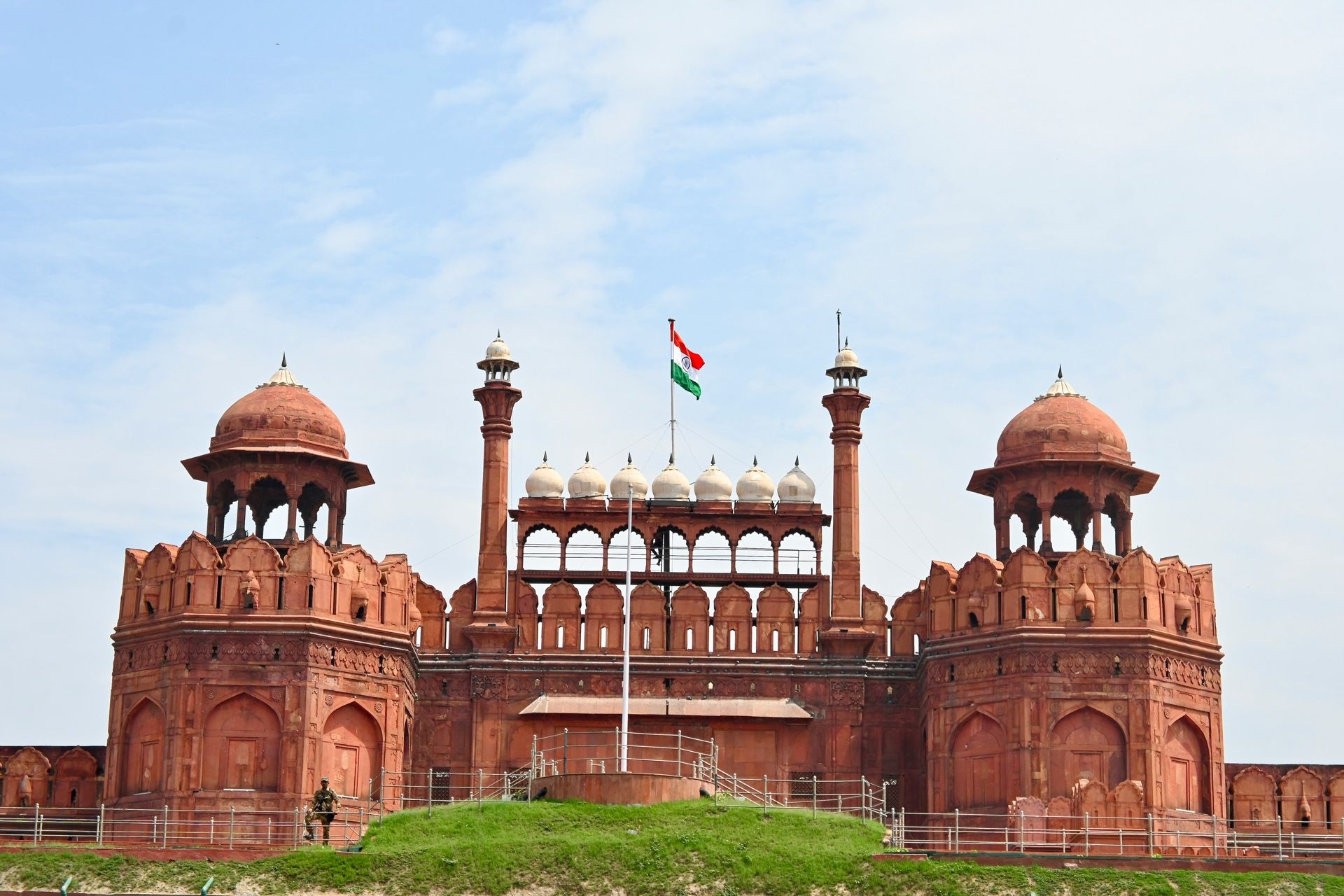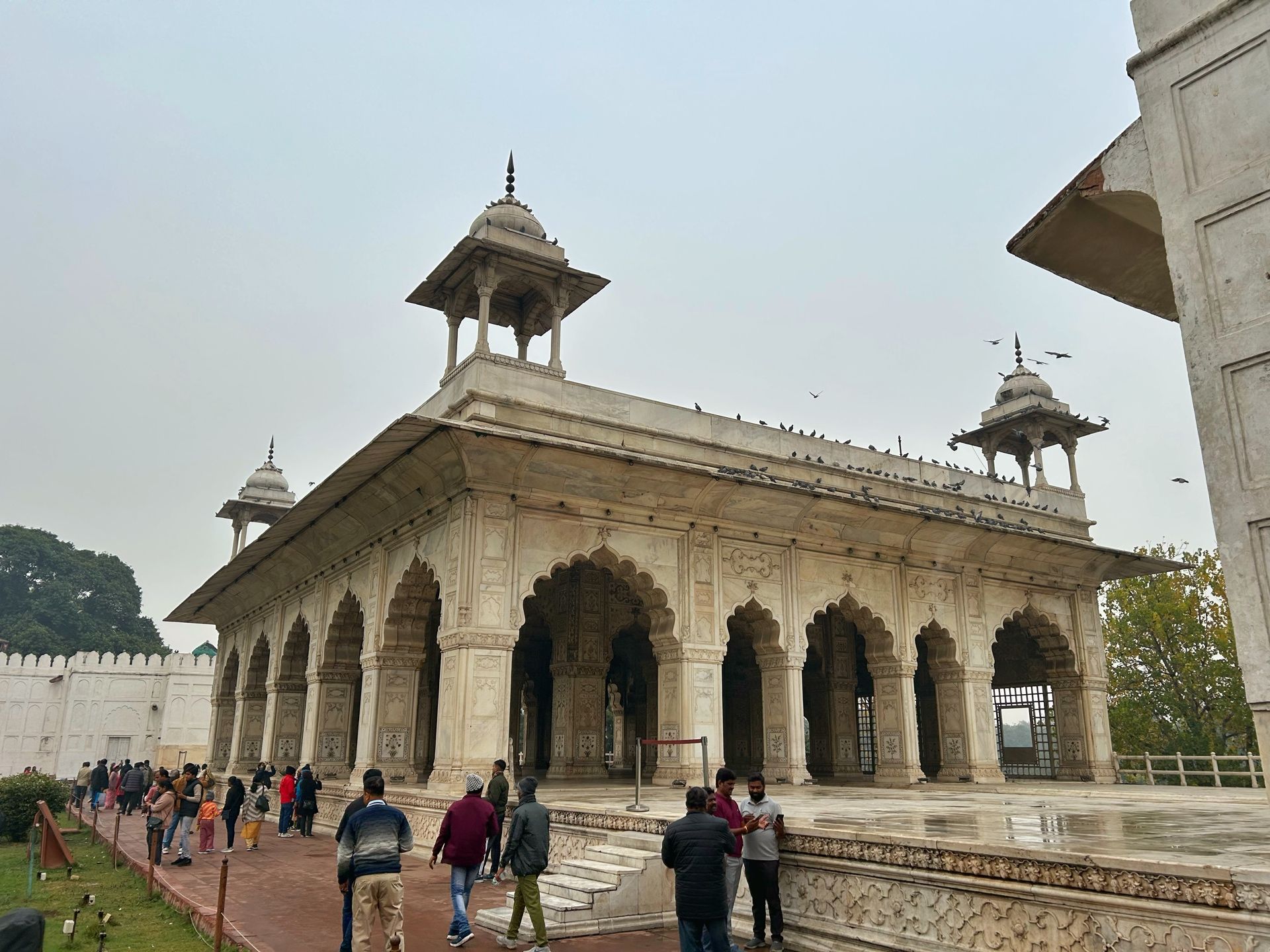
Rising majestically in the heart of Old Delhi, the Red Fort (Lal Qila) is one of India’s most iconic landmarks. Built in the 17th century by Mughal emperor Shah Jahan, this red sandstone fortress once served as the main residence of the Mughal dynasty. Today, it's a UNESCO World Heritage Site and a symbol of India’s rich history and independence.
Whether you're fascinated by architecture, culture, or centuries of history, the Red Fort deserves a top spot on your Delhi itinerary. This guide will help you make the most of your experience.

Quick Visitor Information
Where is the Red Fort located?
The Red Fort is in Old Delhi, near Chandni Chowk and opposite the Jama Masjid.
How much is the entry fee?
For Indian citizens and nationals from Afghanistan, Bangladesh, Bhutan, Maldives, Myanmar, Nepal, Pakistan, Sri Lanka, and Thailand, the entry fee to the Red Fort is ₹35, or ₹56 if you wish to include access to the museums.
For all other foreign tourists, the ticket costs ₹550 and ₹870 with museum access. Entry is free for children under the age of 15, including the museums.
Can the tickets be booked online?
Yes, you can find more information in our Red Fort ticket guide.
What are the opening hours?
The Red Fort is closed on Mondays, and otherwise open daily from 9:30 AM to 4:30 PM

What should I wear when visiting?
While there are no active religious sites inside the Red Fort, it’s best to dress modestly and comfortably. Light cotton clothing and sturdy walking shoes are ideal, as you'll be covering a lot of ground. Since much of the fort is open and exposed to the sun, carrying an umbrella or wearing sunshades is highly recommended.
Are there toilets in the Red Fort?
Yes, public toilets are available inside the Red Fort, mainly near the main entrance and museum areas. Facilities are generally clean and maintained. Wheelchair-accessible toilets are available at designated points, but baby-changing facilities may be limited, so it’s best to plan accordingly if visiting with infants.
What else should I keep in mind before visiting?
Carry a valid ID (passport if you are a foreigner), and keep your ticket handy with you throughout your visit. They are often scanned at exit gates as well. Cloakrooms are available, but it's best to avoid carrying large bags and any eatables inside.
Brief History of Red Fort
The Red Fort, or Lal Qila, was commissioned in 1638 by Mughal emperor Shah Jahan when he shifted his capital from Agra to Delhi. It was designed by the same mind behind the Taj Mahal, architect Ustad Ahmad Lahori, and was conceived as a symbol of imperial power and Mughal creativity. Its massive red sandstone walls, intricate carvings, and grand halls reflect the opulence of the Mughal empire at its peak.
Following the fall of the Mughals, the British took control of the fort in 1857 after the First War of Independence. They destroyed several structures, used it as a military garrison, and left behind a very different legacy.
What makes the Red Fort so famous?
In modern India, the Red Fort holds national importance. Every year on August 15th, the Prime Minister hoists the national flag and delivers an Independence Day speech from its ramparts. Its designation as a UNESCO World Heritage Site in 2007 further cemented its global importance. With its rich past, cultural symbolism, and enduring role in modern India, the Red Fort is famous not only for its architecture but also for the stories and values it represents.
📌 Further read: see our detailed historical account of the Red Fort
What to See & Do Inside the Red Fort
What is there to see inside the Red Fort?
The Red Fort complex is a mini-city of palaces, gardens, and museums. Key highlights include:
Chatta Bazaar (Chatta Chowk): A covered market just inside the Lahori Gate, once reserved for elite shoppers. Today, it still operates as a handicrafts and souvenir market.
Hayat Baksh Bagh: The "Life-Giving Garden," a serene space with once-flowing water channels, pavilions, and Mughal-era landscaping.
Mughal-Era Palaces: Explore Diwan-i-Aam (Hall of Public Audience), Diwan-i-Khas (Hall of Private Audience), royal hammams (baths), Rang Mahal (Palace of Colors), and more.
Museums: Multiple museums inside the fort showcase India’s struggle for independence, the Mughal military, and cultural artifacts.
📌 For more details, see our full guide: Site plan & layout of the Red Fort.
Is there a walking route I should follow?
Yes! Planning a route helps you avoid crowds and get the most out of your visit.
Start at Lahori Gate and pass through Chatta Bazaar
Move on to Diwan-i-Aam (Hall of Public Audience)
Take a detour to the Hayat Baksh Bagh and enjoy the quiet before the crowds arrive
Then return to the central path and explore the royal palaces: Rang Mahal, Diwan-i-Khas, and others
End at the museums, which are best seen toward the end of your visit

How long does it take to see the Red Fort?
With an early start and a clear route, you can comfortably explore the entire fort in about 2 hours. Add an extra 30–45 minutes if you plan to visit all the museums in detail.
Can I take photos inside the Red Fort?
Yes, photography is allowed, but tripods and drone use are prohibited. Some museum areas may restrict photos.
Is there food and drink available to buy at the Red Fort?
Yes, there are small kiosks and stalls inside the Red Fort selling packaged snacks, bottled water, and cold drinks. However, full meals or local street food are not available within the fort complex. For more variety, head to nearby areas like Chandni Chowk or Jama Masjid, which offer plenty of food options.
📌 For suggestions, see our full guide: Food options near Red Fort
Best Photo Spots
The Red Fort is full of stunning backdrops and architectural gems that make it a paradise for photographers. There are at least 4 must-see corners that make the best photo spots to capture your visit:
Lahori Gate & Chatta Chowk

Diwan-i-Aam

Hayat Baksh Bagh

Diwan-i-Khas

Fort Walls & Bastions

Exploring the Red Fort with a Guide
You’ll find guides available for hire right outside the Red Fort, but it’s worth knowing that experiences can vary. There’s no fixed rate, and as a foreign visitor, you might be quoted ₹1,000 or more, especially for tours in non-English languages. Haggling is common, and not every guide is equally knowledgeable or engaging.
If you’d prefer a more flexible and affordable way to explore, our self-guided audio tour is a smart alternative. It lets you discover the Red Fort at your pace, with engaging insights and GPS-based directions that work offline and match your location as you move.
Where to Eat Near Red Fort
Exploring the Red Fort can work up quite an appetite, and luckily, some of Delhi’s best food spots are just a short walk away.
Nearby Food Joints: Head to Chandni Chowk for iconic street food and historic eateries like Karim’s, famous for its rich Mughlai dishes.
Cafes & Street Food: From spicy chaat stalls to refreshing lassis and aromatic kebabs, the Red Fort itself has some cafes that offer a wide range of flavors.
Tips for eating local food safely: Stick to busy stalls with high turnover, avoid tap water, and opt for freshly cooked items to enjoy the best and safest local food experience.
📌 You can read our detailed guide to eating around the Red Fort for specific recommendations.
Other Attractions Near the Red Fort
While you’re visiting the Red Fort, don’t miss these iconic nearby spots that showcase Delhi’s rich history and vibrant culture:
Jama Masjid: One of India’s largest mosques, just a short walk from the fort. Its impressive architecture and panoramic views from the minaret are a must-see.
Raj Ghat: The peaceful memorial site of Mahatma Gandhi, perfect for a reflective stroll and to learn about India’s independence movement.
Chandni Chowk: Delhi’s bustling old market filled with colorful shops, street food, and historic landmarks. It’s an experience that captures the city’s lively spirit.






